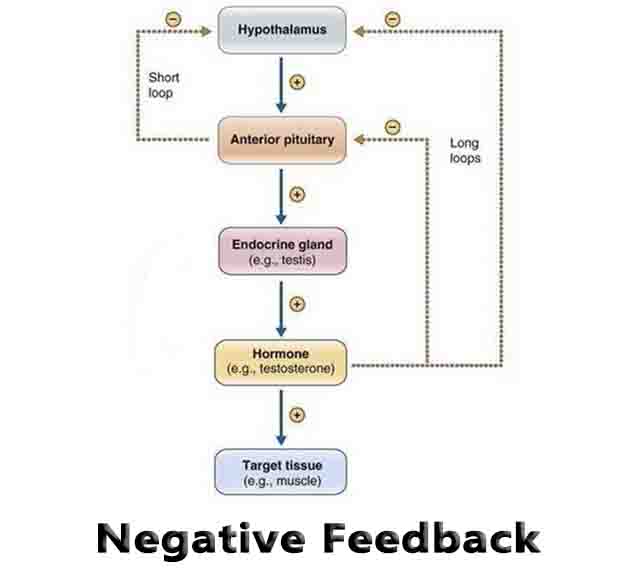Negative Feedback Definition
Negative feedback is a type of regulation in biological systems in which the end product of a process in turn reduces the stimulus of that same process. Feedback, in general, is a regulatory mechanism present in many biological reactions. By allowing certain pathways to be turned off and on, the body can control various aspects of its internal environment.
This is similar to flipping a switch. Feedback allows the product of a pathway to control the switch. Sometimes referred to as a “negative feedback loop”, negative feedback occurs when the product of a pathway turns the biochemical pathway off.
Positive feedback, the opposite of negative feedback, is found in other biological pathways in which the product increases the pathway. Below are examples of negative feedback.
Examples of Negative Feedback
Regulating Blood Sugar
Every time you eat, a negative feedback mechanism controls the level of sugar in your blood. The main sugar found in your blood is glucose. After you eat something, your body absorbs the glucose from your bloodstream and deposits it into your blood. This increases the concentration of glucose and stimulates you pancreas to release a chemical called insulin.
Insulin is a cellular signaling molecule which tells muscle and liver cells to uptake glucose. Liver cells store the excess glucose as glycogen, a chain of glucoses used as a storage product. Muscle cells can store the glucose or use it to make ATP and contract. As this process happens, glucose concentrations are depleted in the blood.
Glucose was the main signal for the pancreas to produce insulin. Without it, the pancreas stops producing insulin and the cells stop taking up glucose. Thus, glucose levels are maintained in a specific range and the rest of the body has access to glucose consistently.
The negative feedback mechanism in this system is seen specifically in how high glucose levels lead to the pathway turning on, which leads to a product meant to lower the glucose level. When glucose becomes too low, the pathway shuts off.
Temperature Regulation
All endotherms regulate their temperature. Endotherms are animals which regulate their bodies at a different temperature than the environment. You can think of mammals and birds as the most common endotherms. Most of the pathways responsible for temperature regulation are controlled by negative feedback.
As the temperature rises, enzymes and pathways in the body are “turned-on”, and control various behaviors like sweating, panting and seeking shade. As the animal does these things, the temperature of their body starts to decrease. The activity of these pathways, which is driven by the heat, also starts to decrease.
Eventually, a temperature is reached at which the pathway shuts off. Other pathways are present for temperatures that are too cold, and are also shut off once the body reaches the optimal temperature. These pathways can be shivering, seeking shelter, or burning fat. All these activities heat the body back up and are shut off by the end product of their reactions, heat.
Filling a Toilet Tank
Many students tend to struggle with abstract biological examples of negative feedback. Have no fear! A simple and common house-hold item uses negative feedback every day. In the tank on the back of your toilet is a ball or float, which rests at water level. When you empty the tank, the water level drops.
The pressure from the float that was holding the valve shut releases, and new water flows into the tank. The valve controlled by the float is like an enzyme that monitors the level of the product it creates.
As more water (product) fills the tank, the float slowly decreases the amount of water being let in through the valve. The valve is analogous to an enzyme which is regulated by feedback from a product it helps create or let into a cell.

